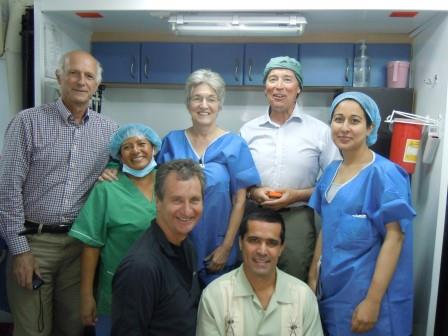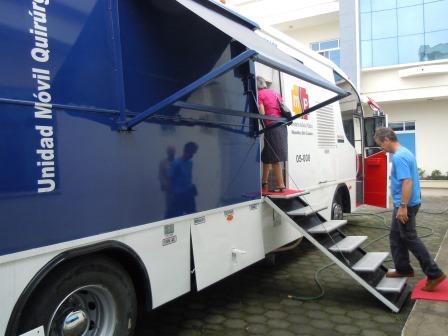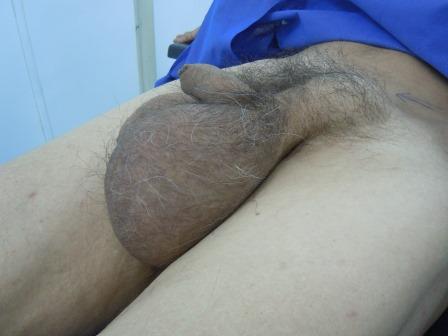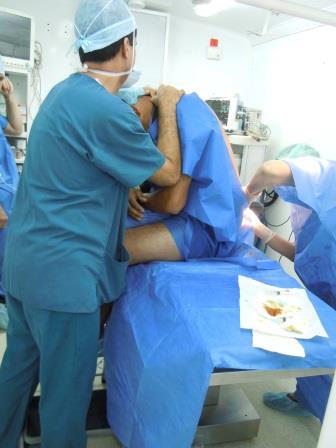
Hernia International Mission, Santo Domingo, Ecuador; January 2015
Team from UK: Mr John Chester (Consultant Surgeon), Mr Nicholas Markham (Consultant Surgeon), Mr Paul Houghton (Consultant Surgeon), Dr Jasmin Lucas (Consultant Anaesthetist), Miss Hina Bhutta (ST4 General Surgery).
Our journey began on the road from Quito to the Province of Santo Domingo de las Tsachilas- a 3 hour drive along the ‘Avenue of Volcanoes’ and a tortuous descent from the dizzying altitude of the Capital to the country’s 3rd largest city. The spiraling road can be combined with dense fog and all manner of vehicles hurtling past at breakneck speed making this a road best travelled with an empty stomach and in the cold light of day!
On arriving in Santo Domingo we were taken straight to the Santo Domingo public hospital where we were acquainted with our tiny (14 x 8 foot) but entirely functional operating theatre in a ‘Unidad mobil Cirugica’ i.e. mobile operating unit, and introduced to the handful of lovely staff with whom we would have the pleasure of working during our short time there.

The next day, business began at 8am promptly. Ecuadorians had traveled from up to 200km away after hearing about the free service through a public campaign by the Ministry of Health and were triaged by the resident Cuban anaesthetist recently recruited to the hospital. Each morning we were shown a rapid-fire sequence of potential patients selected by our Cuban colleague (who spoke Spanish as machine gun fast as he presented patients!) and would select as many as we thought we could manage in a 12 hour shift.
There were challenges throughout our mission. Few Ecuadorians spoke English making communication/ informed consent etc. the first issue. We had arrived anticipating 2 operating tables for our British team of 4 surgeons (3 Consultants, 1 trainee) and 1 anaesthetist (Consultant) but unfortunately were met with only one, limiting the number of procedures we were able to complete. Technical issues also slowed us down such as intermittent loss of water in the mobile unit preventing scrubbing up and breakdown of the autoclave which could be detected by the slightly alarming whiff of singeing filling the little unit! Perhaps one of the most irksome technical challenges was not having a self-retaining retractor, proving to be the bane of one Consultant’s existence (you know who you are JC!).
On a more compassionate level, we all felt sadness and frustration when we had to ask patients to return another day, regardless of how far they had traveled, as we simply could not operate on them all in one day, and for example when patients were presented as having a hernia but clearly has some other diagnosis- including one gentleman with weight loss and a large hard testicular mass, and another gentleman with a 1 year history of flank pain. Turning these patients away without being able to assist further with investigations or appropriate re-referral was a sobering aspect of the mission.

During our time our British team, with the invaluable assistance of Noel the resident anaesthetist and Marlene our adorable Ecuadorian nurse, completed 35 procedures in 29 patients. Broken down, these procedures consisted of 19 inguinal hernias, 2 recurrent inguinal hernias, 10 paraumbilical hernias, 2 epigastric hernias, 1 recurrent incisional hernia and 1 sebaceous cyst. 23 procedures were carried out by the trainee under supervision. All operations were undertaken under spinal anaesthesia. 1 patient with an inguinal hernia repair returned to theatre with minor bleeding.

Despite challenges, the mission was rewarded by virtue of the immense gratitude we received from all of our patients. Without this service, many would continue living with their hernias or have to endure a long wait to receive surgery. Private hernia surgery at a cost of up to $3000 is simply not an option for most of these patients who earn on average only slightly more than this per annum. It was also humbling to be assisted by Marlene and Noel who were not paid overtime for all the extra hours in which they tirelessly aided us and who never stopped smiling. As a trainee, this was an incomparable experience on many levels. I was privileged to have 3 wonderful and patient Consultant surgeons supervising me, and the chance to finally understand the anatomy of hernias (!) and increase my confidence as the operating surgeon.
Thank you to Professor Kingsnorth for this invaluable opportunity and to Kathia Tinizaray Mera, Sandra Ocampo and Teresa Butron for making this mission possible.

